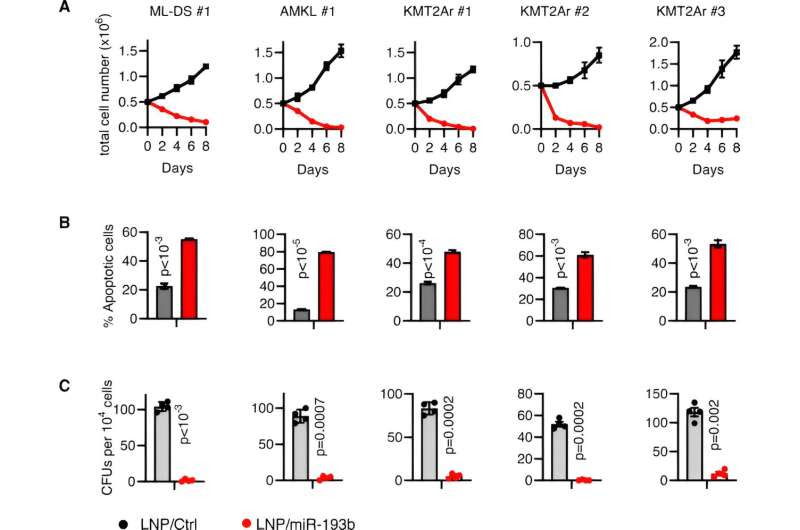by Goethe University Frankfurt am Main

AML xenografts are susceptible to transient LNP/miR-193b treatment in vitro. A The absolute number of human AML PDX cells after treatment with single dose of 4 µg/ml LNPs. B Percentage of apoptotic cells (Annexin V+) on day 2 post treatment. A, B Data are represented as the mean ± standard deviation of three independent biological replicates (two-way ANOVA). C Absolute number of CFUs in methylcellulose-based colony-forming assays of LNPs-treated AML PDXs. Data are shown as the mean ± standard deviation of four plates from two biological replicates (two-way ANOVA). Credit: Leukemia (2023). DOI: 10.1038/s41375-023-01937-6
Each year, about 13,000 people in Germany are diagnosed with leukemia, an umbrella term that encompasses various forms of blood cancer. Among those affected are also many children and adolescents under 15 years of age. A common and very aggressive form of leukemia in adults is acute myeloid leukemia (AML).
In AML, blood cells in the early stages—the stem cells and the precursor cells that develop out of them—transform. AML is the second most common form of leukemia in children, accounting for around 4% of all malignant diseases in childhood and adolescence.
Despite treatment with intensive chemotherapy, only between 20 and 50% survive the first five years after diagnosis and treatment; half or more relapse and die. Furthermore, these intensive therapies have severe side effects: In particular, they damage the stem cells that form new blood. There is therefore an urgent need to develop new therapies tailored specifically to AML.
Researchers led by Professor Jan-Henning Klusmann from the Department of Pediatrics and Professor Dirk Heckl from the Institute for Experimental Pediatric Hematology and Oncology at Goethe University Frankfurt have now tested such a leukemia-specific therapy in animal experiments. They used a therapeutic RNA molecule packaged in lipid nanoparticles to treat animals with leukemia.
The team’s work is published in the journal Leukemia.
“By packaging it in lipid nanoparticles, we have in principle applied the same technique that was used for COVID-19 immunization,” explains Klusmann. “The lipid nanoparticles transport the therapeutic RNA into the blood cells.”
The therapeutic RNA miR-193b was already described in 2018 as having a protective effect against cancer. In healthy cells, miR-193b slows down signaling pathways that are only activated for cell proliferation and which the stem cell otherwise hardly uses. That is why miR-193b is referred to as a tumor suppressor. In AML cells, however, miR-193b is not present in sufficient amounts and therefore unable to fulfill its task as a tumor suppressor.
“Scientists have been testing active substances for many years that act as inhibitors and intervene in these signaling pathways used by AML cells,” says Heckl. “The problem is that such substances only ever attack one component, whereas miR-193b acts on all levels of the signaling pathway. This stops the division of the abnormal cells very efficiently and causes the leukemia cells to die off quickly.”
Another advantage of therapeutic RNAs is that they do not damage the stem cells of the hematopoietic system, unlike conventional chemotherapies, because they are not dependent on the suppressed signaling pathways.
All the laboratory animals tolerated the treatment with the nanoparticles containing the active substance well, and the leukemia cells were successfully fought off. Klusmann summarizes, “We were able to significantly extend survival time in all the animals we treated, and some were even cured.”
What is particularly encouraging is that miR-193b worked in all the AML subtypes tested: The scientists examined four different types of cancer cells in their trials, including one common in people with Down syndrome.
“In the past, noncoding RNAs and their genes were regarded as junk DNA,” explains Klusmann. “Now we have developed a therapy based on this ‘junk’ that promises a new and very specific treatment option for myeloid leukemia.” The hope is that this therapy can support chemotherapies in the future so that they do not have to be so intensive.
More information: Hasan Issa et al, Preclinical testing of miRNA-193b-3p mimic in acute myeloid leukemias, Leukemia (2023). DOI: 10.1038/s41375-023-01937-6
Journal information: Leukemia
Provided by Goethe University Frankfurt am Main

Leave a Reply